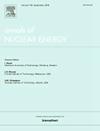Study on in-vessel injection strategy for IVR improvement
IF 1.9
3区 工程技术
Q1 NUCLEAR SCIENCE & TECHNOLOGY
引用次数: 0
Abstract
In-vessel retention (IVR) of molten core debris is a significant severe accident management strategy to prevent vessel failure and subsequent debris relocation to the containment. High-risk ex-vessel phenomena such as steam explosion, core-concrete interaction (CCI) that may challenge the containment integrity are eliminated by successful IVR measures. In unmitigated severe accident, loss of cooling leads to core heat-up and molten debris relocates into the plenum of reactor vessel. High heat flux from molten pool to the vessel may melt through the wall, which depends on stratification of the debris and critical heat flux (CHF) of the ex − vessel surface. The debris configuration used to be postulated as a metal layer floating on the oxide layer. Nowadays thin metal layer over an oxide layer and bottom metal layer configuration is considered as the limiting and reasonable assumption. For high power nuclear power plant (NPP) with less metal in molten pool, if three-layer molten pool formed in the reactor vessel lower head, top thin metal layer may lead to focusing effect and challenge the integrity of vessel. In-vessel injection is recommended to mitigate focusing effect.CAP1400 is designed as passive GEN-III PWR and adopts IVR as main severe accident management strategy. For CAP1400 NPP IVR design, reactor cavity flooding system provides enough containment water level for natural circulation ex-vessel cooling, which is beneficial to water backflow from break. Emergency operating procedure (EOP) and severe accident management guideline (SAMG) also instruct plant staff recovering other engineering injection path to the reactor vessel manually. Therefore lower head debris decay heat removal is achieved by both in-vessel and ex-vessel cooling. Experiments show that debris top cooling heat transfer is enhanced compared to the one predicted by film boiling correlation. Heat transfer model was established to investigate the top cooling capability, including natural convection, radiation heat transfer, nucleate boiling and film boiling. Two classic three − layer molten pool scenarios were analyzed, according to the CAP1400 severe accident sequence and debris quality participated in interaction. Results show that some of the three − layer assumption cannot lead to vessel failure without in − vessel injection. For more limiting three − layer case, heat flux to the vessel wall decreases lower than CHF with conservative top cooling heat flux. Based on the test and deterministic assessment, there is reasonable assurance that the IVR strategy is successful by both in-vessel and ex-vessel cooling.
求助全文
约1分钟内获得全文
求助全文
来源期刊

Annals of Nuclear Energy
工程技术-核科学技术
CiteScore
4.30
自引率
21.10%
发文量
632
审稿时长
7.3 months
期刊介绍:
Annals of Nuclear Energy provides an international medium for the communication of original research, ideas and developments in all areas of the field of nuclear energy science and technology. Its scope embraces nuclear fuel reserves, fuel cycles and cost, materials, processing, system and component technology (fission only), design and optimization, direct conversion of nuclear energy sources, environmental control, reactor physics, heat transfer and fluid dynamics, structural analysis, fuel management, future developments, nuclear fuel and safety, nuclear aerosol, neutron physics, computer technology (both software and hardware), risk assessment, radioactive waste disposal and reactor thermal hydraulics. Papers submitted to Annals need to demonstrate a clear link to nuclear power generation/nuclear engineering. Papers which deal with pure nuclear physics, pure health physics, imaging, or attenuation and shielding properties of concretes and various geological materials are not within the scope of the journal. Also, papers that deal with policy or economics are not within the scope of the journal.
 求助内容:
求助内容: 应助结果提醒方式:
应助结果提醒方式:


